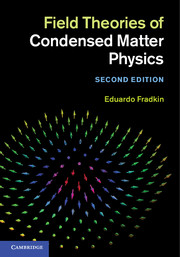Book contents
- Frontmatter
- Contents
- Preface to the second edition
- Preface to the first edition
- 1 Introduction
- 2 The Hubbard model
- 3 The magnetic instability of the Fermi system
- 4 The renormalization group and scaling
- 5 One-dimensional quantum antiferromagnets
- 6 The Luttinger liquid
- 7 Sigma models and topological terms
- 8 Spin-liquid states
- 9 Gauge theory, dimer models, and topological phases
- 10 Chiral spin states and anyons
- 11 Anyon superconductivity
- 12 Topology and the quantum Hall effect
- 13 The fractional quantum Hall effect
- 14 Topological fluids
- 15 Physics at the edge
- 16 Topological insulators
- 17 Quantum entanglement
- References
- Index
1 - Introduction
Published online by Cambridge University Press: 05 March 2013
- Frontmatter
- Contents
- Preface to the second edition
- Preface to the first edition
- 1 Introduction
- 2 The Hubbard model
- 3 The magnetic instability of the Fermi system
- 4 The renormalization group and scaling
- 5 One-dimensional quantum antiferromagnets
- 6 The Luttinger liquid
- 7 Sigma models and topological terms
- 8 Spin-liquid states
- 9 Gauge theory, dimer models, and topological phases
- 10 Chiral spin states and anyons
- 11 Anyon superconductivity
- 12 Topology and the quantum Hall effect
- 13 The fractional quantum Hall effect
- 14 Topological fluids
- 15 Physics at the edge
- 16 Topological insulators
- 17 Quantum entanglement
- References
- Index
Summary
Field theory and condensed matter physics
Condensed matter physics is a very rich and diverse field. If we are to define it as being “whatever gets published in the condensed matter section of a physics journal,” we would conclude that it ranges from problems typical of material science to subjects as fundamental as particle physics and cosmology. Because of its diversity, it is sometimes hard to figure out where the field is going, particularly if you do not work in this field. Unfortunately, this is the case for people who have to make decisions about funding, grants, tenure, and other unpleasant aspects in the life of a physicist. They have a hard time figuring out where to put this subject which is neither applied science nor dealing with the smallest length scales or the highest energies. However, the richness of the field comes precisely from its diversity.
The past few decades have witnessed the development of two areas of condensed matter physics that best illustrate the strengths of this field: critical phenomena and the quantum Hall effect. In both cases, it was the ability to produce extremely pure samples which allowed the discovery and experimental study of the phenomenon. Their physical explanation required the use of new concepts and the development of new theoretical tools, such as the renormalization group, conformal invariance, and fractional statistics.
- Type
- Chapter
- Information
- Field Theories of Condensed Matter Physics , pp. 1 - 7Publisher: Cambridge University PressPrint publication year: 2013



